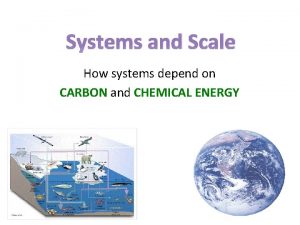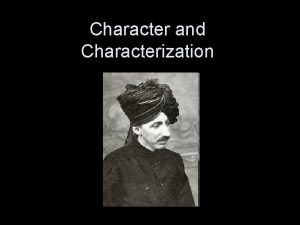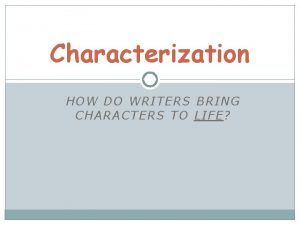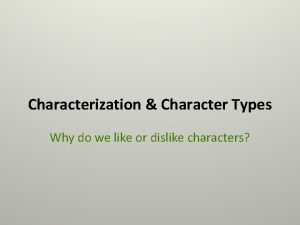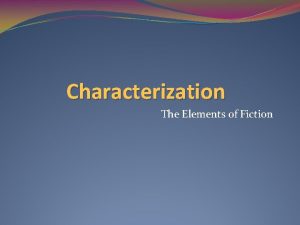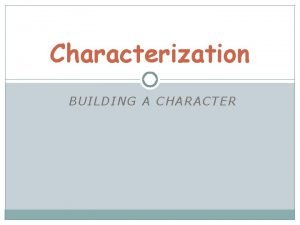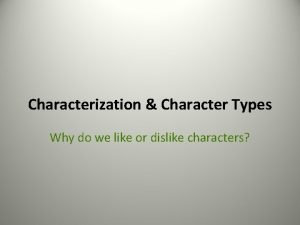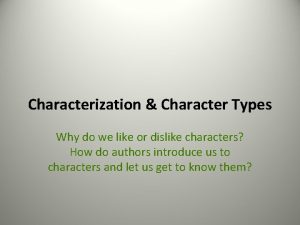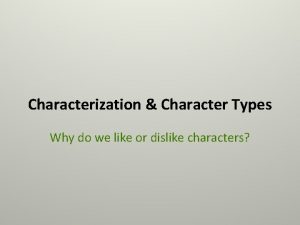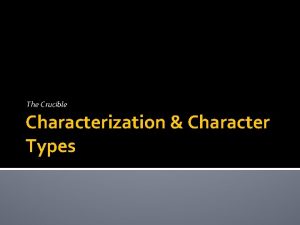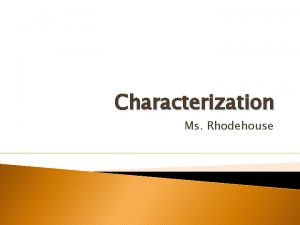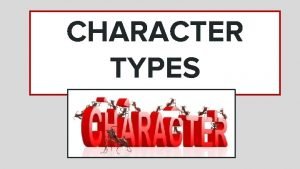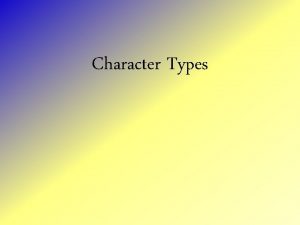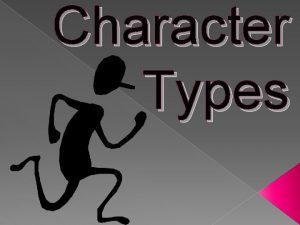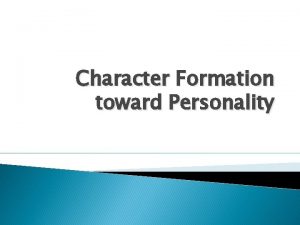Characterization Character Types Why do we like or














- Slides: 14

Characterization & Character Types Why do we like or dislike characters?

Characterization • There are two ways authors reveal a character to readers.

1. Direct Characterization • An author TELLS you what a character is like. – Ex. – Scout loved reading. – Ex. — Calpurnia was a tyrant.

2. Indirect Characterization • The author SHOWS you what a character is like through their actions, thoughts, and interactions. – Ex. – Jem had his little sister to think of the time I dared him to jump off the top of the house: “If I got killed, what’d become of you? ” he asked (Lee 17). – Ex. — “Inside the house lived a malevolent phantom […] From the Radley chickenyard tall pecan trees shook their fruit into the schoolyard, but the nuts lay untouched by the children: Radley pecans would kill you” (10 -11).

Direct or Indirect? “Dill was a curiosity. He wore blue linen shorts that buttoned to his shirt, his hair was snow white and stuck to his head like duckfluff; he was a year my senior but I towered over him” (9). “Jem gave a reasonable decription of Boo: Boo was about six-and-a-half feet tall, judging from his tracks; he dined on raw squirrels and any cats he could catch, that’s why his hands were bloodstained” (16). “The Radley Place fascinated Dill. In spite of our warnings and explanations it drew him as the moon draws water, but drew him no nearer than the light-pole on the corner, a safe distance from the Radley gate. There he would stand, his arm around the fat pole, staring and wondering” (10).

Major and Minor Characters • Major Characters: the one or two main characters who dominate the story. • Minor Characters: help tell the major characters’ tale by interacting with major characters and showing aspects of their personality.

Major and Minor Character Examples Major Characters: • Jem • Scout Minor Characters: • Calpurnia • Miss Stephanie Crawford So where do characters like Atticus, Boo Radley, and Dill fit? Let’s sort the characters together.

The MAJOR Characters • Protagonist: the central character in the work – NOTE: NOT necessarily a “hero”. Sometimes our main characters are not heroes. • Antagonist: the opponent/enemy of the protagonist. The antagonist often causes the central conflict.

We know Scout is the protagonist, but who is her antagonist? • • Boo Radley? Aunt Alexandria? Bob Ewell? Racism?

Characters are either Dynamic or Static • Dynamic: a character who changes as a result of the plot. • Static: A character who stays the same throughout the story.

Characters are either Round or Flat • Round Character: a complex character. There are many aspects of his/her personality. • Flat Character: usually static and shown to have only one or two aspects.

• Major Characters are usually ROUND and DYNAMIC • Minor Characters are usually STATIC and FLAT.

Character Foils • A character who contrasts with the major character in one of two ways: 1. The opposite of the major character. 2. The foil resembles the major character, but with lesser versions of the character’s personality. * Purpose: the contrast between main character and foil highlights makes the main character appear brighter.

Discuss with a partner: • Who is a character foil to Scout? Explain why.
 Hey bye bye
Hey bye bye Why does ethanol look like water but behave more like wood?
Why does ethanol look like water but behave more like wood? Whats direct characterization
Whats direct characterization Indirect characterization example
Indirect characterization example Don't ask why why why
Don't ask why why why Characterization of a character
Characterization of a character Static character definition
Static character definition Character and characterization
Character and characterization 2 types of characterization
2 types of characterization Is jem a round or flat character
Is jem a round or flat character Type of characterization
Type of characterization Types of characterization
Types of characterization Would prefer grammar
Would prefer grammar Remo ualberta
Remo ualberta Which features of the sun look like huge cloudlike arches
Which features of the sun look like huge cloudlike arches

